Table of Contents |

Meet Wanda. Wanda is a retail associate who’s been hearing a lot about AI lately. Outside of work, she has always wanted to learn how to play the ukulele, but she doesn’t know where to start. Could AI give her some simple steps to begin, the same way it might later help her in her work and career? Wanda is curious, but this is her very first time trying it out, and she isn’t sure what to type.
Generative AI tools don’t read your mind. They respond to exactly what you type. If your prompt is too broad or too vague, the answer will be broad and vague too.
When writing prompts, it’s helpful to think about three things:
Let’s look at a couple of examples. Imagine you wanted to improve your listening skills to provide better customer service. You might start with this prompt:

Like with Wanda, that answer is correct, but it’s not as useful as it could be. The prompt is pretty broad, asking only for "tips on how to be a better listener.” Changing the prompt to make it more specific will yield more helpful results.

Notice how the new prompt adds focus and context. The result is a more useful answer.
In addition to adding focus and context, you can adjust prompts to get different kinds of results. For example, you can ask the AI to write in plain language, give bullet points, or summarize in one sentence. You can even ask it for an easy-to-remember acronym.

With clearer, more specific prompts, the answers should have become much more practical. Remember, vague prompts lead to vague answers. Specific prompts lead to responses you can actually use.
One of the biggest differences between an AI chatbot and a Google search is that the chatbot remembers the context of your session. In other words, it keeps track of what you have already asked and answered and uses that to shape its next response.
This doesn’t mean it learns about you forever. Once the chat session ends, the memory is gone. But within a single conversation, it can build an understanding of what you are asking for and adjust its answers so you don’t have to start your whole prompt over from scratch each time.
The short animation below shows how a single conversation can build step by step. Each new prompt adds a twist, and the AI adapts its answers without losing track of the original topic.
GAIA01
Notice how the second answer builds on the first one. The chatbot remembered what the first answer was about and adapted it to the new request. Each request builds on the original prompt and doesn't need repeating.
The AI is not using this data to re-train itself. Instead, the chatbot is maintaining a temporary "session memory," which allows it to keep track of the ongoing conversation while the session is active. Once the session ends, this memory is cleared, and the AI doesn’t carry over details from one conversation to another. This session-based design helps create more natural, flowing interactions while still allowing you to start a new, "blank” conversation when it’s needed.
While your words are not training the AI in real time, they could be stored and used to improve future models. That means you should always think carefully before sharing sensitive or private information, whether it’s personal information, or work-related. In fact, most companies who are encouraging people to use AI provide an approved generative AI chatbot that is safe to use for work topics and projects.
Treat AI chats like any other online space: be thoughtful, be cautious, and protect your data. We’ll talk more about privacy in the context of AI in Unit 4.